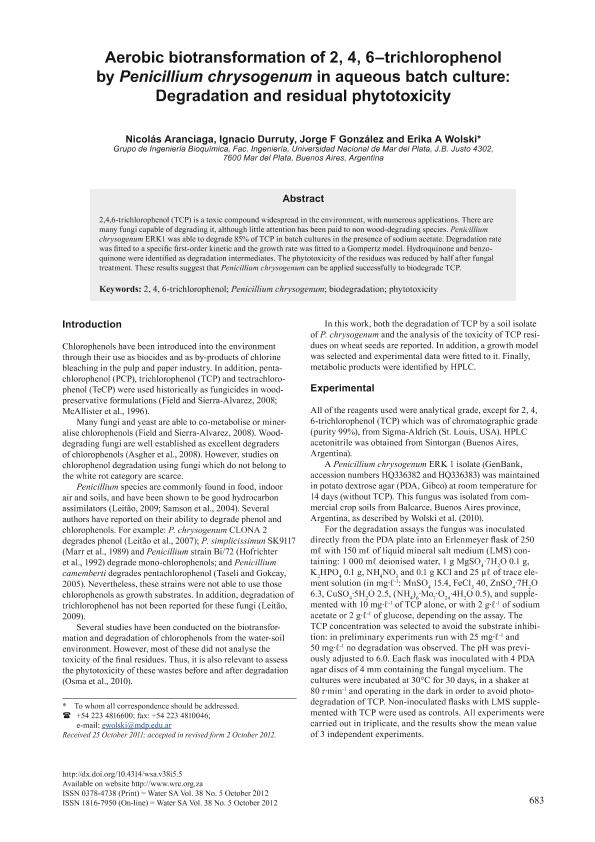Mostrar el registro sencillo del ítem
dc.contributor.author
Aranciaga, Nicolas
dc.contributor.author
Durruty, Ignacio

dc.contributor.author
Gonzalez, Jorge Froilan

dc.contributor.author
Wolski, Erika Alejandra

dc.date.available
2023-05-18T12:32:13Z
dc.date.issued
2012-10
dc.identifier.citation
Aranciaga, Nicolas; Durruty, Ignacio; Gonzalez, Jorge Froilan; Wolski, Erika Alejandra; Aerobic biotransformation of 2, 4, 6-Trichlorophenol by Penicillium chrysogenum in aqueous batch culture: Degradation and Residual Phytotoxicity; Water Research Commission; Water S.A.; 37; 4; 10-2012; 683-688
dc.identifier.issn
0378-4738
dc.identifier.uri
http://hdl.handle.net/11336/197959
dc.description.abstract
2,4,6-trichlorophenol (TCP) is a toxic compound widespread in the environment, with numerous applications. There are many fungi capable of degrading it, although little attention has been paid to non wood-degrading species. Penicillium chrysogenum ERK1 was able to degrade 85% of TCP in batch cultures in the presence of sodium acetate. Degradation rate was fitted to a specific first-order kinetic and the growth rate was fitted to a Gompertz model. Hydroquinone and benzo- quinone were identified as degradation intermediates. The phytotoxicity of the residues was reduced by half after fungal treatment. These results suggest that Penicillium chrysogenum can be applied successfully to biodegrade TCP.
dc.format
application/pdf
dc.language.iso
eng
dc.publisher
Water Research Commission

dc.rights
info:eu-repo/semantics/openAccess
dc.rights.uri
https://creativecommons.org/licenses/by-nc-sa/2.5/ar/
dc.subject
degradation 2,4,6, trichlorophenol
dc.subject
Penicillium chrysogenum
dc.subject
batch biodegradation
dc.subject
phitotoxicity
dc.subject.classification
Otras Ingeniería del Medio Ambiente

dc.subject.classification
Ingeniería del Medio Ambiente

dc.subject.classification
INGENIERÍAS Y TECNOLOGÍAS

dc.title
Aerobic biotransformation of 2, 4, 6-Trichlorophenol by Penicillium chrysogenum in aqueous batch culture: Degradation and Residual Phytotoxicity
dc.type
info:eu-repo/semantics/article
dc.type
info:ar-repo/semantics/artículo
dc.type
info:eu-repo/semantics/publishedVersion
dc.date.updated
2023-05-17T11:18:55Z
dc.identifier.eissn
1816-7950
dc.journal.volume
37
dc.journal.number
4
dc.journal.pagination
683-688
dc.journal.pais
Sudáfrica

dc.description.fil
Fil: Aranciaga, Nicolas. Universidad Nacional de Mar del Plata. Facultad de Ingeniería. Departamento de Ingeniería Química. Grupo de Ingeniería Bioquímica; Argentina
dc.description.fil
Fil: Durruty, Ignacio. Universidad Nacional de Mar del Plata. Facultad de Ingeniería. Departamento de Ingeniería Química. Grupo de Ingeniería Bioquímica; Argentina. Consejo Nacional de Investigaciones Científicas y Técnicas. Centro Científico Tecnológico Conicet - Mar del Plata; Argentina
dc.description.fil
Fil: Gonzalez, Jorge Froilan. Consejo Nacional de Investigaciones Científicas y Técnicas. Centro Científico Tecnológico Conicet - Mar del Plata; Argentina. Universidad Nacional de Mar del Plata. Facultad de Ingeniería. Departamento de Ingeniería Química. Grupo de Ingeniería Bioquímica; Argentina
dc.description.fil
Fil: Wolski, Erika Alejandra. Consejo Nacional de Investigaciones Científicas y Técnicas. Centro Científico Tecnológico Conicet - Mar del Plata; Argentina. Universidad Nacional de Mar del Plata. Facultad de Ingeniería. Departamento de Ingeniería Química. Grupo de Ingeniería Bioquímica; Argentina
dc.journal.title
Water S.A.

dc.relation.alternativeid
info:eu-repo/semantics/altIdentifier/url/https://www.ajol.info/index.php/wsa/article/view/71452
Archivos asociados
